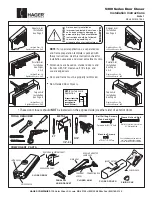
English 11 English
Maintenance
General
Twice a year, depending on the use of the device,
inspect the following:
cleanliness of the pwer source
electrical and gas connections
Perform calibration of the current and voltage
settings.
Check electrical connections of the power, control
and power supply circuits.
Check the condition of insulation, cables,
connections and pipes.
Perform a compressed air cleaning
WARNING
Never carry out cleaning or repair work inside the
device before making sure that the unit has been
completely disconnected from the mains.
Dismantle the generator panels and use suction to
remove dust and metal particles accumulated between
the magnetic circuits and the windings of the
transformer.
Work must be performed using a plastic tip to avoid
damage to the insultation of the windings.
At each start-up of the welding unit and prior to calling
customer cupport for technical servicing, please check
that:
Power terminals are not improperly tightened.
The selected mains voltage is correct.
There is proper gas flow.
Type and diameter of the wire.Torch condition.
Torch
REGULARLY CHECK THE PROPER TIGHTNESS
OF THE CONNECTIONS OF THE WELDING
CURRENT SUPPLY. MECHANICAL STRESSES
RELATED TO THERMAL SHOCKS TEND TO
LOOSEN SOME PARTS OF THE TORCH,
PARTICULARLY:
The contact tube
The coaxial cable
The
welding
nozzle
The quick connector
Check that the gasket of the gas inlet spigot is in
good condition.
Remove the spatter between the contact tube and
the nozzle and between the nozzle and the skirt.
Spatter is easier to remove if the procedure is
repeated at short intervals.
Do not use hard tools that may scratch the surface of
these parts and cause spatter to become attached to
it.
Blow out the liner after each change of a spool of
wire. Carry out this procedure from the side of the
quick fitting connector plug of the torch.
If necessary, replace the wire inlet guide of the torch.
Severe wear of the wire guide may cause gas leaks
towards the rear of the torch.
The contact tubes are designed for long use.
Nevertheless, the passage of wire causes them to
wear off, widening the bore more than the
permissible tolerances for good contact between the
tube and the wire.
The need to replace them becomes clear when the
metal transfer process becomes unstable, all the
settings of the work parameters remaining otherwise
normal.
Rollers and wire guide
UNDER NORMAL CONDITIONS OF USE, THESE
ACCESSORIES HAVE A LONG SERVICEABLE LIFE
BEFORE THEIR REPLACEMENT BECOMES
NECESSARY.
Sometimes, however, after being used over a period of
time, excessive wear or clogging due to adhering
deposits may be noted.
To minimise such harmful effects, make sure the wire
feeder plate remains clean. The motor reduction unit
requires no maintenance.
WARNING
For any maintenance or repair operations it is
recommended to contact the nearest technical service
center or Lincoln Electric. Maintenance or repairs
performed by unauthorized service centers or
personnel will null and void the manufacturers warranty.
The frequency of the maintenance operations may
vary in accordance with the working environment. Any
noticeable damage should be reported immediately.
Check cables and connections integrity. Replace,
if necessary.
Keep clean the machine. Use a soft dry cloth to
clean the external case, especially the airflow inlet
/ outlet louvers.
WARNING
Do not open this machine and do not introduce anything
into its openings. Power supply must be disconnected
from the machine before each maintenance and
service. After each repair, perform proper tests to
ensure safety.
Output Connections
A quick disconnect system using Twist-MateTM cable
plugs is used for the welding cable connections. Refer to
the following sections for more information on connecting
the machine for operation of stick welding (MMA) or TIG
welding.
(+) Positive Quick Disconnect: Positive output connector
for the welding circuit.
(-) Negative Quick Disconnect: Negative output connector
for the welding circuit.
Stick Welding (MMA)
First determine the proper electrode polarity for the
electrode to be used. Consult the electrode data for this
information. Then connect the output cables to the output
terminals of the machine for the selected polarity.
Shown here is the connection method for DC(+)










































